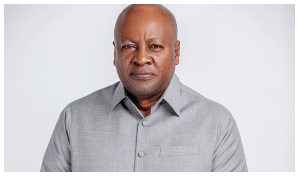Ghana government's introduction of the Universal QR Code payment system has been cited by Finextra, an internationally-renowned financial news publication, as an example of a new payment revolution that is sweeping through the world in the wake of COVID-19.
Ghana became the first African country to introduce the Universal QR Code Payment System when Vice President, Dr. Mahamudu Bawumia launched it last month.
While QR codes are popular in several advanced countries and are used for different functions, Ghana joined a handful of countries in the world that has introduced the universal QR Code Payment System, a system which allows customers to make electronic payments for goods and services from any bank account and mobile money wallet with their mobile phones.
Writing extensively on the new payment system the world is adopting, Finextra named Ghana as a classic example, alongside countries such as China, Saudi Arabia and Brazil.
With several countries getting ready to roll out the new payment system in the wake of COVID-19, Ghana has acted proactively and become a pacesetter in a new order, especially on the African continent.
Below is the full, unedited article by Finextra:
In the wake of COVID-19, QR codes are taking over the world. Will Visa and MasterCard survive?*
The coronavirus pandemic has taught people to use QR codes in new and broader ways.
This presents a great opportunity to shake up international payment systems with their wildly expensive commissions - and move to something better.
QR codes are one of humankind’s brilliant inventions, and yet, they are still underestimated. In developed countries, they are mainly used as graphical hyperlinks leading to sites or other information. However, with QR codes, you can also create a cashless payment infrastructure - quickly and inexpensively.
This opportunity is now actively used by countries with developing economies, including China, India and Brazil. It also appears the coronavirus crisis could well spread this practice around the world, moving the QR code-based fintech industry towards a definitive breakthrough.
Today, we see how the process of market education has evolved: COVID-19 has forced authorities in China, France, Qatar and other countries to implement QR codes actively used to track the health status of citizens and their movements. QR codes are becoming a familiar part of everyday life, making it not only possible but necessary to expand the scope and use of this technology, primarily in the field of finance.
How QR code payments work
A QR code with a payment link can be generated by both the seller and the buyer, however, it is usually sellers that generate QR codes. The process looks like this:
The seller creates a QR code and shows it to the buyer.
The buyer scans the QR code using their banking or finance application and clicks the "Pay" button.
The monetary transfer is sent to the seller’s bank.
The seller receives a payment confirmation and the payments system issues a receipt to the buyer.
There are two types of QR code: static and dynamic.
Static codes are created in advance and can be printed out and placed near the cash register. Once scanned by the buyer, they enter the payment amount on the smartphone, which is then processed when they press the “Buy” button.
Dynamic codes are generated for a specific payment and already contain an amount for payment, as determined by the seller.
Pros and cons of QR code payments
The QR code payment infrastructure has a number of advantages over Visa and MasterCard’s offerings today.
Firstly, the cost of making QR payments is lower than that of Visa and MasterCard, since unnecessary intermediaries - Visa and MasterCard themselves - are eliminated from the process. Therefore, QR code-based payment systems, at a minimum, can offer a reduction in commissions, which is very attractive to businesses, who can then offer more competitive pricing to customers.
In the future, QR payments may even become free due to the distribution and legalization of open source solutions by regulators. In the meantime, commissions will depend on the greed of the banks and their willingness to change business models, reducing their share of transaction income, in favour of, for example, a more honest business model, such as subscriptions. Judging by the fact that most progressive fintechs have chosen a subscription model, the future of this option looks bright.
Secondly, to organize digital, non-cash payment by QR codes, entrepreneurs do not need expensive equipment and no payment terminals. All that’s needed is a smartphone, which almost everyone has today. Price tags with QR codes can be printed on stickers using a regular printer. The buyer also needs to have any phone with a camera and an installed banking application.
Thirdly, thanks to QR codes, the digital payments infrastructure is becoming more open, as it is easier to integrate new financial instruments, including cryptocurrencies, into it.
QR codes can be used not only in ordinary stores but also in e-commerce, in instant messengers and on any screen, any app and any surface they can be displayed on or affixed to.
Of course, QR code payment technology also has disadvantages.
The main problem is the risk of fraud, which is directly related to the main advantage, being the simplicity of generating codes. Attackers can replace existing codes with their own, hacking an online store or replacing a printed code in an offline retail outlet. However, there are already mechanisms that can deal with this.
The British regulator has ordered the country's largest banks to send push notifications to users with information about the seller and additional confirmation for the transaction.
The Bank of Scotland was first to introduce this procedure, and the other major banks in the U.K. should do this before June 30, 2020.
QR codes are the hope for SMEs and the underbanked
Due to the COVID-19 induced economic crisis, small and medium-sized businesses, as well as buyers, will benefit from the spread of digital payment systems based on QR codes.
It is in these groups that the main costs of the cashless world are now born. Large retail chains always have lower commission costs than smaller stores around the corner. Buying terminals for a small business is also a greater financial burden than for huge corporations.
Regarding the effect of COVID-19 crisis on SMEs, QR codes are able to solve all current issues at once. If we analyze the potential through the prism of B2B, then payments can be digitized, simplified, streamlined and secured.
In addition, QR codes give unbanked people access to digital non-cash payments, increasing the inclusivity of the financial industry. It's not just for the inhabitants of countries with developing economies, either, with the Financial Conduct Authority estimating that there are 1.3m people without a bank account in the UK alone, with those numbers concentrated in big cities.
Thus far, QR codes have enjoyed increasing adoption in different parts of the world, and the forecast for their growing role in the financial system is more than promising.
QR payments move around the world
The potential of payments using QR codes is perfectly demonstrated by the example of China: offline scan-to-pay transactions have grown 15 fold over the past three years, reaching 9.6 trillion yuan (US$ 1.3 trillion) in the fourth quarter of 2019.
We’re now seeing QR code payment systems rolling out across the world.
One example is Saudi Payments, a fully owned subsidiary of the Saudi Arabia Monetary Authority, which has appointed High-tech Payment Systems (HPS) to introduce a QR-based national payment system, which is an interoperable unified QR code platform that enables seamless interaction between all stakeholders.
A second example is the government of Ghana launching the ‘Universal QR Code’ - a new payment system solution which ‘reduces the technological challenges associated with operating a cash-lite society’.
A third example is the Central Bank of Brazil, which has also introduced a new standard for QR codes aimed at the creation of a pro-competitive environment and greater payments transparency.
COVID-19 has pushed the world to cashless payments, especially with the fear that physical currency can potentially be a virus transmission vector. Now is the chance to establish a new generation of payments best practices, or we can maintain the status quo and allow Visa and MasterCard to dictate their terms to every outlet, all over the world.
Click to view details



Business News of Sunday, 19 April 2020
Source: www.ghanaweb.com

















